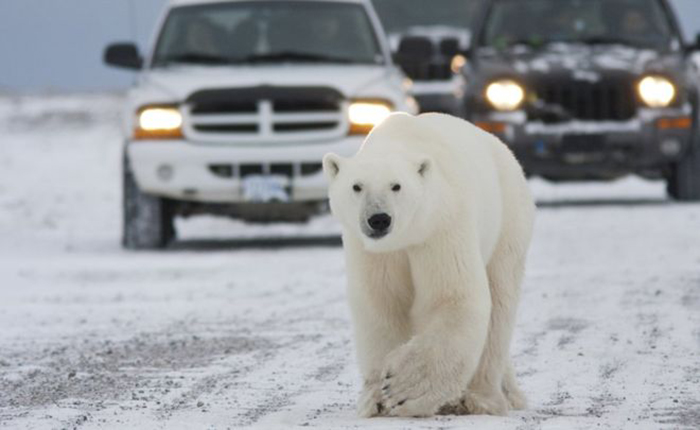Inuit men and women, accustomed to close encounters with polar bears, seem to be no less in awe of this creature than I am. There are gasps of delight at the bear`s antics, and informed discussion about its age, size and sex - and the reasons why it is behaving like this.
This is the seventh or eighth bear I have seen in as many days. Daily, I join townspeople on the dock near my house. Binoculars are passed around as we watch a mother bear and two yearling cubs on the snowy slope on the far side of the inlet.
I visit the wildlife officer one afternoon and find him at his huge office window, peering out at the sea ice through a telescope.
He stands aside so I can take a look. The same mother and cubs are on the sea ice, closer to town. But they are not alone. As the sub-adult cubs saunter ahead with their distinctive pigeon-toed gait, the mother fights off the advances of a male bear. She repeatedly rises up on her hind legs, showing the male her full size, in an attempt to ward off his advances. Cubs are often killed by male bears, so this mother is defending the lives of her offspring.
One evening, my friend Darlene Gibbons takes me to the town dump in her truck. Along with others in trucks, on snowmobiles and all-terrain vehicles, we suffer the smells of the rubbish and the neighbouring sewage lagoon, in order to watch the polar bears that come scavenging at this time of year.
People and polar bears have always lived side-by-side in this part of the world but in the past it was rare for bears to enter the town. Now, every summer and autumn, it`s becoming an uncomfortable part of everyday life.
I first lived in Arviat, a community of 2,500 people in Canada`s Nunavut Territory, for 10 months between 2000 and 2001, volunteering at the local school. I returned a year later to carry out a year of research for a PhD in anthropology. Arviat has been central to my professional and personal life ever since, and I go back as often as I can. As an anthropologist, I am drawn to the relationships between Arviarmiut - as the Inuit of Arviat are called - and the beluga whales, seals, caribou, and other animals that share their Arctic home. But it is the relationship between people and polar bears that fascinates me above all else.
Polar bears tower over humans, sometimes measuring as much as 12 feet from nose to tail. But Inuit believe that humans and bears have much in common. When bears rear up on their hind legs to sniff the air, to play, to attack or defend themselves, they resemble two-legged humans. And like Inuit, bears are at home on both sea ice and land. At sea they hunt the same marine mammal species for sustenance - humans and bears are rival predators at the top of the food chain.
For Inuit, these similarities suggest a close relationship. Bears are powerful spiritual beings that, in mythology, interact with everyone from the most powerful shamans to the most defenceless orphans. Arviat elder Johnny Karetak once told me that bear attacks on humans are neither arbitrary nor random. "Bears attack down the family line, like a curse," he said. "The bears would look out for one particular person. They knew him well."
In winter 2007, I spent 16 days at a polar bear hunting camp. The oldest hunter, the Rev Jimmy Muckpah, was 71 years old, a respected elder, Arviat`s Anglican minister, and the most experienced polar bear hunter in town. One afternoon, a bear wandered into camp and scavenged some meat that lay on the sea ice. One of the younger hunters, a man in his 30s, began throwing small pebbles. These repeatedly hit the bear on the head, causing it to flinch, but otherwise not distracting it from the meat. Jimmy chastised the younger man for showing disrespect to the animal. Some hours later, when the younger man complained of a headache, Jimmy was not surprised. "You tried to hurt the bear`s head," he said. "So the bear has given you a headache."
This illustrates another element of the relationship between Arviarmiut and bears. Encounters with bears are common, but harm to either humans or bears is rare. For the most part, each treats the other with caution.
Arviarmiut meet bears while hunting beluga whales and fishing for Arctic char in summer, while berry picking on the tundra in autumn, and during autumn and winter seal hunting along the shore and on the sea ice. Bears break into hunting cabins (occasionally with sleeping families inside) attracted by the smell of food. Hunters have been attacked in their tents and there have been some close shaves, but it is many years since a human was badly injured by a polar bear in Arviat.
My hunting companions have often put me on bear patrol while they butcher beluga whales, scan the sea for seals or clean fishing nets. It is my job to look out for bears, or to watch the movements of bears already present, and alert my friends if a hasty retreat is called for. The bears we encounter are usually curious rather than aggressive, standing up to sniff the air, and waiting patiently for their turn with the carcass. But vigilance is critical as curiosity can quickly turn to aggression and, over certain terrain, a polar bear can easily outrun the all-terrain vehicles Arviarmiut use in summer and autumn.
More about:















































